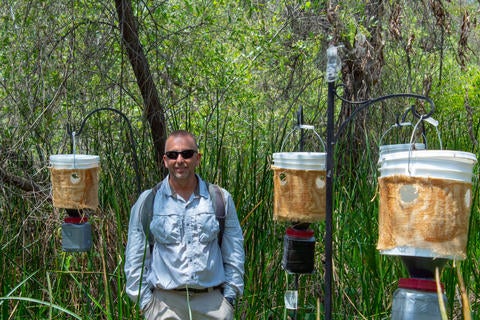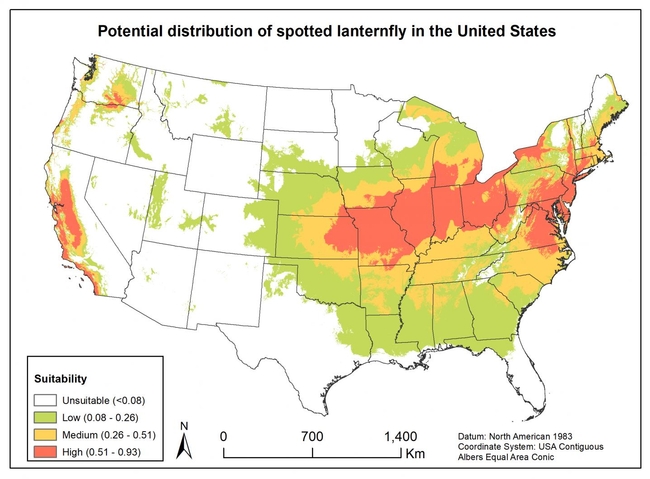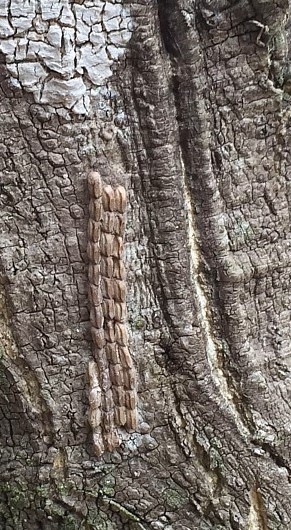

University of California
Cooperative Extension Ventura County
Posts Tagged: lantern fly
Where to Look for Spotted Lantern Fly. Really a Planthopper
IMAGE: This is a map of possible establishment of Spotted Lanternfly in the US. view more
Credit: ARS-USDA
WAPATO, WASHINGTON, October 3, 2019--Maps identifying the areas suitable for establishment of the spotted lanternfly (SLF) in the United States and other countries have been published in the Journal of Economic Entomology by Agricultural Research Service scientists.
The SLF, originally from China, has spread to Korea and Japan, and has been found most recently in the United States in Pennsylvania, New Jersey, Virginia and Delaware. These insects are pests of many agricultural crops including almonds, apples, blueberries, cherries, peaches, grapes and hops as well as hardwoods such as oak, walnut and poplar, among others. USDA and state partners have been working to contain SLF populations since 2014.
There is the potential for far reaching economic damage if the SLF becomes widely established in the United States.
Within the United States, SLF could eventually become established in most of New England and the mid-Atlantic states, the central United States, and Pacific coastal states, explained ecologist Tewodros Wakie with the ARS Temperate Tree Fruit and Vegetable Research Unit in Wapato, Washington, who led the project.
"Earlier attempts to predict the spread of the spotted lanternfly using a less sophisticated model had indicated a potential for the pest to become established in warmer areas such as southeastern Florida and in tropical countries," Wakie said. "But we made use of a more complex model called MAXENT that depends on a wider number of environmental factors including temperature, elevation and rainfall as well as the current known locations of the species.
MAXENT has proven to be much more accurate at predicting where species are likely to spread compared to 16 other methods on 266 species.
"There are numerous examples where new populations of species were discovered following MAXENT predictions. Our lab group used MAXENT to predict the potential distribution of oriental fruit moth, and apple maggot, and predictions have been more accurate than anything previously," said Wakie.
Eleven European countries and large parts of the Northeast United States and the Pacific Northwest were found to be prime habitat for SLF establishment in place of tropical locales with MAXENT.
The most important factor in predicting SLF establishment is the mean temperature of the driest quarter of the year; it cannot be too hot or too cold, about 0 degrees C plus or minus 7 degrees C (a temperature range between 19 and 45 degrees F), Wakie explained.
Another important factor in predicting SLF's possible range is the presence of the tree of heaven--an invasive plant that also originated from China. Although not the only host plant for SLF, it is a highly important host plant for the insect. Studies are underway to identify additional host plants and to find the right biocontrol system.
Results from this study can be used to guide SLF surveys and prioritize management interventions for this pest,
And for Biocontrol options?
https://ucanr.edu/blogs/blogcore/postdetail.cfm?postnum=30826
And more on the planthopper:
https://academic.oup.com/ee/advance-article/doi/10.1093/ee/nvz123/5606651
https://academic.oup.com/jee/advance-article/doi/10.1093/jee/toz259/5572115

Spotted-lantern-fly-Adults-1024x394
Here Comes Another Avocado Pest - Humpf - Biocontrol Can Handle It
UC Riverside is testing whether a sesame seed-sized wasp can control a pest that could seriously damage California crops including wine, walnuts, and avocados.
The pest, a sap-sucking spotted lantern fly, is originally from China and was first detected five years ago in Pennsylvania. Since then, large populations have spread rapidly to grape vines, apple trees, and other plants in New York, Delaware, New Jersey, Maryland, and Virginia.
Experts believe the lantern fly is likely to make its way to California soon.
Mark Hoddle, director of the Center for Invasive Species Research at UC Riverside, explains why the lantern fly is so harmful.
“It secretes copious amounts of “honeydew,” a waste product that encourages black, sooty mold and damages a plant's ability to grow,” he said. The honeydew also attracts undesirable insects such as ants and hornets.
The impacts could extend well beyond California. According to industry reports, the state is the world's fourth-largest wine producer, selling an estimated $35 billion domestically and exporting $1.5 billion annually.
Around 44% of nonnative insects arriving in California were first established elsewhere in the U.S. Given the speed with which the spotted lantern fly has spread, Hoddle realized the state needed a proactive approach to this predictable problem.
“Normally, when a bug shows up, we try to contain and eradicate it,” Hoddle said. “But by the time the population is found, it tends to already be widespread and hard to handle.”
The state Department of Food and Agriculture recently granted Hoddle $544,000 to test whether a tiny parasitic wasp, also originally from China, could be the solution to the looming problem. Hoddle explained that the wasp has a needle-like appendage it uses to lay its own eggs inside the lantern fly's eggs. While developing, the wasp larvae eat and kill their hosts, and then emerge after chewing escape holes through the lantern fly eggs.
These wasps pose no threat to plants or people, but before they can be used to control the lantern fly, Hoddle must prove they won't cause unnecessary harm to other native insects. “We can't just release a Chinese parasite into the wild in California,” Hoddle said. “Chances are low it will harm the wrong targets, but we have to be sure.”
Safety testing will be conducted in a highly secure quarantine facility at UC Riverside. Native lantern flies, the subjects of safety testing, will be collected from natural areas in California and southern Arizona this summer.
Though the wasp is now being evaluated as a biological control on the East Coast, populations of lantern fly there have already grown large enough to cause significant concern for the grape industry, Hoddle said.
A spotted lantern fly's wingspan is about 1.5 inches, and at most they can fly a few hundred feet at a time if they're assisted by the wind. The lantern fly has spread so fast in part because the females lay eggs on nonbiological materials, such as train cars, motor homes, wooden pallets, and trucks that inadvertently move them into new territories.
“Anyone on the East Coast driving to California should be especially vigilant about checking their vehicle for egg masses before they make the journey,” Hoddle warned. “Failing to notice them could have serious consequences.”
Hoddle's testing will take roughly three years, and he estimates that this may be around the time when the wasps will be needed in California. “We hope to be ready to release these wasps immediately when the spotted lantern fly shows up, giving us a really strong head start on the invasion,” he said.

reposted from: https://news.ucr.edu/articles/2019/06/17/looming-insect-invasion-threatens-california-wine-and-avocados
Great video of Lantern Fly life stages from Penn State
https://www.youtube.com/watch?v=Wumtju2_0JM
Photo: Lantern fly egg mass

Spotted-lantern-fly-Adults-1024x394


